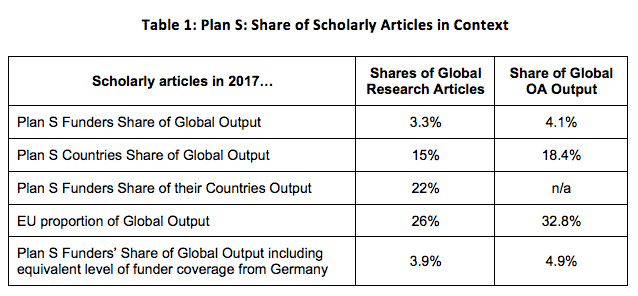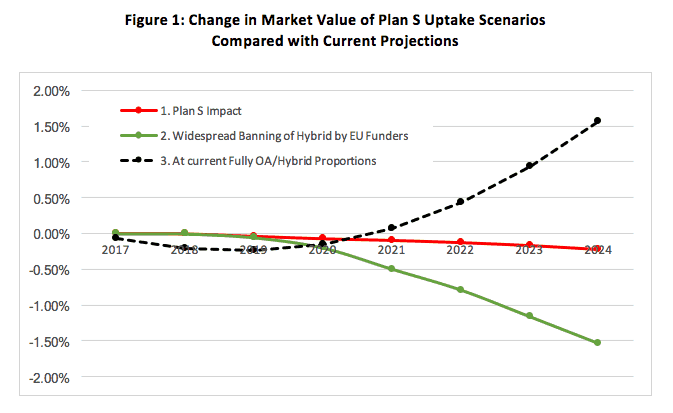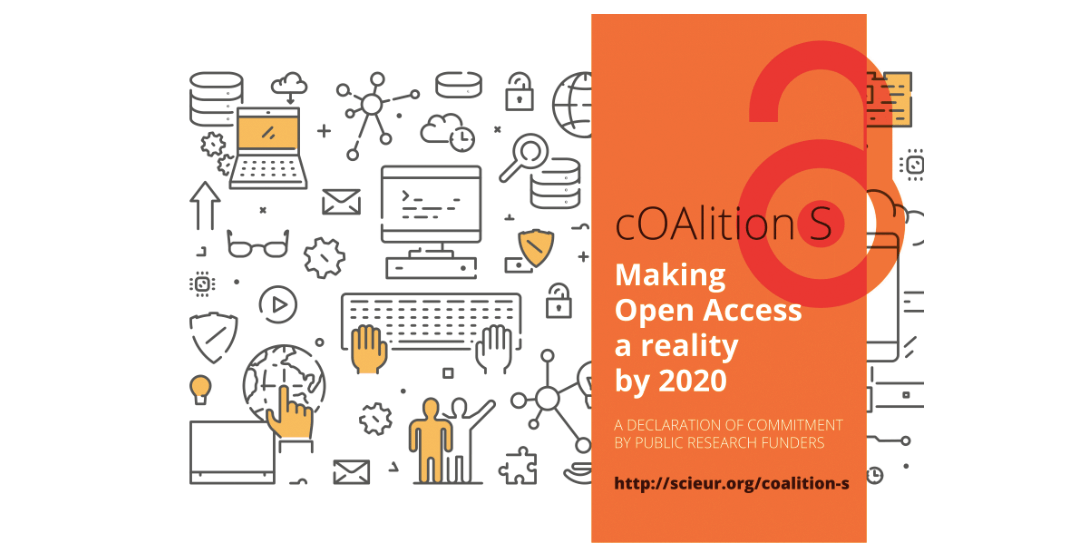On 4th September 2018, 11 national European funding agencies (cOAlition S) announced Plan S, an initiative requiring every paper funded by its participants to be made freely available in fully OA publications as of 1st January 2020.
Earlier this year we considered how a few possible future scenarios might affect the scholarly publishing market overall. Plan S is related to two of those models: APC funding caps and moving away from hybrid. This month we will consider what effects Plan S might have on the value of the marketplace.
Influence
Since Plan S is put forward by 11 European funders, we begin by determining how much of the market they influence. The funders state they control around €7.6 ($8.8) Billion of funds annually. This represents less than 1% of the nearly $2 Trillion global spend on R&D.
However, it is the academic papers arising from Plan S funders’ R&D activities that determine the effects on the scholarly publishing market. In this context, Plan S funders have a more significant influence. Working with Digital Science, combining data from their Dimensions product with data from Delta Think’s Open Access Data & Analytics Tool, we can determine approximate proportions of output (papers published) as shown below in Table 1.

Source: Data provided by Dimensions from Digital Science – collected on 13 September 2018, US Science & Engineering Indicators 2016, Delta Think Open Access Data & Analytics Tool, Delta Think analysis.
We estimate that Plan S funders account for roughly 3.3% of articles published globally. These include all articles where a Plan S funder is involved, even as part of a jointly-funded or multi-author project. Although many of the Plan S funders are national, they account for just over one fifth of their respective countries’ publication output. Also, as Plan S funders are OA advocates, they account for a higher than average share of OA output.
Plan S principles are also consistent with other OA-advocacy countries (Germany), several institutions (University of California), funders (Bill & Melinda Gates Foundation), and with the broader EU principles of a move to OA by 2020. It is reasonable to posit that Plan S will gain additional support from a variety of OA stakeholders. One such example is Germany. Its absence from inclusion may well be a matter of the timing due to its on-going publisher negotiations, rather than differences in long-term position.
Effects
Plan S includes a number of principles that impact the market. Its preamble and principles mention banning publication in hybrid journals, requiring CC-BY licenses to be held by the author, instituting caps on APC funding, and the cOAlition S view on using the Journal Impact Factor for quality assessment. However, without additional information on the nature and scope of APC funding caps, for example, there is nothing to model. In assessing the potential effects on the market, we focused on the banning of hybrid.
The effects of the following two scenarios on the market, at its current levels, are shown in the chart below. We adjusted our previously modelled effects of a wholesale move to hybrid to include:
- Plan S Impact, covering the OA output arising from Plan S funders plus a pro-rated uptake of Plan S principles by German funders. We think this represents a reasonable view of how Plan S will roll out with a core set of funders.
- Widespread Banning of Hybrid by EU Funders, covering OA output of all EU countries, at a rate of OA uptake half way between the global average and that of high OA-uptake countries – e.g. UK, Austria, Netherlands, Sweden. This covers a view of widespread adoption of Plan S or similar principles.

Source: Delta Think Open Access Data & Analytics Tool, Delta Think analysis.
With our current market projections as a baseline (0%), we plotted how the scenarios would compare. Negative values suggest less money flowing into the scholarly publishing market as compared with the current trends.
- We estimate that Plan S will remove 0.1% (one tenth of one percent) of the value of market by 2022, rising to remove around 0.25% percent in 7 years’ time.
- If Plan S becomes widespread, the effects are more profound: a 0.6% reduction in market value in 2021 and 1.83% reduction in 7 or so years.
- Article revenues, prices and the balance between hybrid and fully OA have been changing over time. Our baseline projections assume these changes continue. But if we project forward at current prices and business model splits, we see scenario 3. This is an important nuance. If perceptions are based on current levels of spending, they may overstate trends in the long term.
It is important to note that Plan S lacks clarity on execution and, likely because of this, includes the paragraph below, which indicates the coalition’s willingness to receive transition plans from publishers. If the publishers engage with the coalition in this fashion, the impact of the plan could be less immediate.
“We acknowledge that ‘transformative’ type of agreements, where subscription fees are offset against publication fees, may contribute to accelerate the transition to full Open Access. Therefore, it is acceptable that, during a transition period that should be as short as possible, individual funders may continue to tolerate publications in ‘hybrid’ journals that are covered by such a ‘transformative’ type of agreement. There should be complete transparency in such agreements and their terms and conditions should be fully and publicly disclosed.”
Conclusions
As we have discussed in our analysis of consortia cancellations, the early, concerted action of a few may not move the needle alone, but could be the beginning of a snowball effect. The question is whether the Plan S snowball will roll down the mountain, growing as it goes, or simply melt away.
The figures suggest that, even at its current levels of coverage, Plan S will take revenue out of the scholarly publishing market, and so reduce its growth. Although the effects may seem small, annual market growth is a modest 2% per year. The 0.1% reduction in market value by 2022 suggested by our models is equivalent to a 5% change from underlying growth rates.
Given Plan S principles are consistent with those of some currently non-participating organizations, others are likely to join, as we discuss above. Widespread uptake across the EU (or funders adopting similar principles in other regions) could see annual market growth reduce by a quarter to a long-term 1.5% annual figure.
An amplification effect appears to be driving the dynamics. Plan S funders attach their conditions to part-funded papers, so multi-author or joint-funded papers enable them to affect research beyond their immediate sphere of influence. Being at the vanguard of OA, the participating funders are more likely to give rise to OA publications and so pay above average in publication costs.
Reactions to Plan S have ranged from delighting OA advocates, to suggesting that this is simply a part of the on-going discussion about OA, to responses from the mainstream scholarly publishing community urging for more detailed consideration of the complexities of the scholarly publishing market, to concerns from some researchers that it will “… deprive them of quality journal venues and of international collaborative opportunities…”.
Whatever your position, the use of hybrid journals as a temporary stepping stone to a fully OA world is hardly news. Plan S is clearly aimed at accelerating change in this direction, and our data suggest that its small core of funders can have a significant effect.
We will have to wait to see how publishers respond and if alternative transition plans and agreements are put in place. Meanwhile, the Plan S snowball may not barrel down the mountainside in record time, but, considered in conjunction with the sentiment of other key stakeholders in the ecosystem, it seems unlikely to melt away.

TOP HEADLINES
OECD Launches Second Pilot of International Survey of Scientific Authors (ISSA2) – September 20, 2018
“The OECD has launched the second pilot of the International Survey of Scientific Authors (ISSA2). This survey aims to collect statistical evidence on the use of digital tools for science and on their impact on different scientific activities.”
Hindawi Ltd. Launches Open-Source Peer Review System Built on the PubSweet Framework – September 18, 2018
“Hindawi Limited is pleased to announce the launch of a new peer review platform built using the Collaborative Knowledge Foundation’s (Coko) open source PubSweet framework. Hindawi’s system is launching on the open access journal Bioinorganic Chemistry and Applications.”
Knowledge Unlatched and IntechOpen collaborate to support Open Access books in engineering– September 15, 2018
“Knowledge Unlatched (KU), the Open Access Marketplace, and IntechOpen, one of the leading providers of Open Access academic books, have formed a partnership to support researchers working in engineering. Over the next three years, they will publish around 300 open access books in the engineering sciences.”
ESSOAr Selects Hypothesis to Enable Open Annotation on their Open Discovery and Dissemination Service for Early Research Outputs – September 14, 2018
“AGU, Atypon, and Hypothesis announced the selection of Hypothesis’ open source annotation framework to provide annotation capabilities on the Earth and Space Science Open Archive (ESSOAr), the open discovery and dissemination service for early research outputs, including preprints and posters presented at major scientific meetings.”
Bringing Greater Transparency to Peer Review: Wiley and Clarivate Analytics Partner to Launch Innovative Open Peer Review – September 13, 2018
“John Wiley and Sons Inc., Publons, and ScholarOne today announced the launch of the scholarly industry’s first scalable open peer review workflow. Beginning with Wiley’s journal Clinical Genetics, this is the first open peer review initiative to develop a scalable model applicable to diverse publishing processes.”
Wellcome Trust & Karger join the Blockchain for Peer Review Initiative – September 12, 2018
“Karger Publishers has recently joined the Blockchain for Peer Review initiative. After Springer Nature, Cambridge University Press and Taylor & Francis, Karger is the fourth publisher to join the efforts towards making peer review more transparent, efficient and recognizable. Additionally, the Wellcome Trust has joined the Blockchain for Peer Review initiative as an advisor.”
MIT Open Access Task Force releases white paper – September 7, 2018
“The ad hoc task force on open access to MIT’s research has released ‘Open Access at MIT and Beyond: A White Paper of the MIT Ad Hoc Task Force on Open Access to MIT’s Research,’ which examines efforts to make research and scholarship openly and freely available.”
Preprint: “We’re still failing to deliver open access and solve the serials crisis” by Toby Green – September 6, 2018
“A new preprint, posted on Zenodo, which updates the opinion paper about our failure to deliver open access that Green published in Learned Publishing a year ago. In this new paper, Green reviews how the open access landscape has evolved over the past twelve months and propose a novel approach that might help solve both the challenge of delivering open access and solve the serial crisis.”
Simba: Viability of Open Access Books Remains Uncertain – August 30, 2018
“Two years after Simba Information first published a report on the subject of open access (OA) books, the collective business model remains unproven. The latest edition of Open Access Book Publishing 2018-2022 found that total revenue generated from book processing charges (BPC) remains small.”
ASAPbio: Open letter on the publication of peer review reports – August 28, 2018
Publishers are promoting transparency in the peer review process by signing ASAPbio’s open letter: “We enable or undertake to enable the publication of all of the content of peer review, but not necessarily the names of reviewers (this is also called open peer review reports) and author responses alongside final, published articles.”
Plan S Round-Up
cOAlition S: Making Open Access a reality by 2020 – September 4, 2018
“On 4 September 2018, 11 national research funding organisation, with the support of the European Commission and the European Research Council (ERC), announced the launch of cOAlition S, an initiative to make full and immediate Open Access to research publications a reality. It is built around Plan S, which consists of one target and 10 principles.”
European science funders ban grantees from publishing in paywalled journals – September 4, 2018
“Frustrated with the slow transition toward open access (OA) in scientific publishing, 11 national funding organizations in Europe turned up the pressure today. As of 2020, the group, which jointly spends about €7.6 billion on research annually, will require every paper it funds to be freely available from the moment of publication.”
EU and national funders launch plan for free and immediate open access to journals – September 4, 2018
“The European Commission and a group of national research funders have laid out a controversial and perhaps precedent-setting plan to make thousands of research papers free to read on the day of publication, in a move that could force a major change in the business model of science publishers.”
STM statement on Plan S: Accelerating the transition to full and immediate Open Access to scientific publications – September 4, 2018
“The International Association of Scientific, Technical and Medical Publishers (STM) welcomes the efforts by funders to work towards our shared goals of expanding access to peer-reviewed scientific works to maximize their value and reuse, but urges caution that the next steps in this transition avoid any unintended limitations on academic freedoms, and continue to ensure the overall viability and integrity of the scholarly record.”
Thoughts on Plan S by Peter Suber – September 4, 2018
An overview and review of Plan S as well as its strengths and weaknesses. “The plan is admirably strong. It aims to cover all European research, in the sciences and in the humanities, at the EU level and the member-state level. It’s a plan for a mandate, not just an exhortation or encouragement.”
Science without publication paywalls: cOAlition S for the realisation of full and immediate Open Access – September 4, 2018
“In this Perspective, a group of national funders, joined by the European Commission and the European Research Council, announce plans to make Open Access publishing mandatory for recipients of their agencies’ research funding.”
New coalition of European funders join together to place unprecedented mandate on researchers to publish OA – September 5, 2018
“A promising new initiative aimed at greatly accelerating the migration to a fully Open Access research environment in Europe was announced: Plan S…SPARC Europe supports cOAlition S and Plan S, and is actively working on ways to aid their success.”
European countries demand that publicly funded research be free – September 15, 2018
“Eleven European countries, including Britain, France and the Netherlands, have signed up to what is called ‘Plan S.’ This requires scientists who benefit from those countries’ national-research funding organizations to publish their work only in open-access journals on freely accessible websites by 2020.”
OA JOURNAL LAUNCHES
September 17, 2018 | IET launches three new Open Access Journals showcasing the best of engineering science | “The Institution of Engineering and Technology’s (IET) Open Programme has added three more fully Gold Open Access journals to its collection spanning the subjects of Energy, Manufacturing and Cognitive Systems: IET Collaborative Intelligent Manufacturing, IET Energy Systems Integration, and Cognitive Computation and Systems (CCS).” |
September 12, 2018 | The Optical Society Launches New Gold Open Access Journal, OSA Continuum | “The Optical Society (OSA) today published the first issue of its newest peer-reviewed, Gold Open Access journal, OSA Continuum. OSA Continuum joins OSA’s diverse portfolio of journals and provides a home for work that meets OSA’s high standards for accuracy, rigor and quality, without judgment of novelty or impact.” |
September 6, 2018 | IOP adds Environmental Research Communications to its journal lineup | “IOP Publishing is launching Environmental Research Communications (ERC) as the newest addition to its journal portfolio. ERC is an inclusive Open Access journal for the rapid publication of high-quality research in all areas of environmental science.” |
September 6, 2018 | Microbiology Society announces the launch of a new Open Science journal, Access Microbiology | “The Microbiology Society is excited to announce the launch of their new Open Science journal, Access Microbiology. The journal introduces a new service to members of our community, allowing the publication of replication studies, negative or null results, research proposals, data management plans, additions to established methods, and interdisciplinary work.” |


DISCUSSION
Comments are closed.